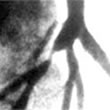
|
If you have chest pain caused by a narrowing in one or more coronary arteries, your cardiologist may recommend balloon angioplasty to open the blockage, followed by placement of a small metal scaffolding (a stent) to support the re-opened vessel When doctors put in a stent, they look at an X-ray screen to guide the placement of the device. Doctors have traditionally relied on these X-ray views, called angiograms, to assess the condition of the arteries and decide where a stent might be beneficial. Two emerging technologies can help doctors determine more precisely when and where to place a stent. Sometimes called “Intravascular Guidance Tools,” Intravascular Ultrasound (IVUS) and Fractional Flow Reserve (FFR) are images and measurements that give the doctor a closer look inside the artery, and more information about how well blood is flowing through the artery to the heart.
Some studies have indicated that when doctors use IVUS and FFR, they may get better results for patients, avoid unnecessary angioplasties and stents, and make sure the stents they place are in the best possible position. All of that benefits you, the patient. Naturally patients only want stents when and where they really need them, and they want those stents to work as well as possible. FFR and IVUS seem like very technical subjects for patients to learn about! But the pace of change in medicine is extremely rapid. Only a minority of interventional cardiologists are currently employing these new technologies. Using new technology involves additional training for physicians and an investment in new equipment by the hospital.
Angioplasty.Org offers this information so that those patients interested in seeking out state of the art approaches to their treatment can educate themselves, and discuss these concepts with their physicians. And, doctors do listen to patients: if the patient community lets physicians know they prefer having access to catheterization labs with the latest in imaging equipment, then doctors will be more inclined to petition their hospitals to make an investment in IVUS and FFR. Of course millions of stents have been successfully placed by highly skilled cardiologists without the benefit of these new technologies. And even doctors that use FFR and IVUS don’t feel it is necessary in all cases. Your relationship with your physician is paramount and both communication and trust are important. The goal of learning about treatment is not to second-guess your doctor, but to partner with your physician. As an educated patient, discussing new treatments, technologies and research with your doctor, regardless of which treatments or technologies you and your doctor decide are right for you, can improve communication and enhance your confidence and sense of participation in your own health. Asking your cardiologist about IVUS and FFR is one more way of knowing you have done everything you can to get yourself the best heart disease treatment possible.
FFR: How Doctors Can Measure What’s
Causing Your Pain A traditional angiogram shows a picture of the blood vessels so that doctors can see where there are obstructed or narrowed areas. But until now it has been difficult to determine just how much a given narrowing in an artery is actually affecting blood flow. Sometimes what appears on an angiogram X-ray to be a significant blockage in an artery is actually not slowing blood flow, or causing chest pain. Studies have shown that unless a blockage is restricting blood flow, there is no need for a procedure like angioplasty or bypass surgery to open the blockage (called “revascularization”) and patients can be treated safely with medication and lifestyle changes.
So measuring the blood flow inside the artery, which is what FFR does, can prevent unnecessary treatment. In fact, studies suggest that FFR may decrease the use of stents by as much as a third. Using FFR can also identify narrowings that require treatment but may have been missed using angiography alone. Sometimes a small but idiosyncratic narrowing can in fact be restricting blood flow to the point where it is causing debilitating pain. The FFR device is inserted using the same catheter system that is used for a standard diagnostic catheterization or angioplasty and is done at the same time, so it does not involve any additional discomfort or visits for the patient.
IVUS: Looking at Your Arteries from the Inside
Out
Interpretation of IVUS imagines requires training and practice. How often IVUS is used depends on the physician – some use it routinely, others only in especially difficult cases. So, it’s a good idea to discuss strategic use of IVUS with your interventional cardiologist. Like FFR, IVUS is done during a standard diagnostic catheterization or angioplasty procedure using the same catheter system that has already been inserted for the angiogram, so it does not impact your experience as a patient.
Reported by Deborah Shaw, Patient Education Editor, September 27, 2011 |




